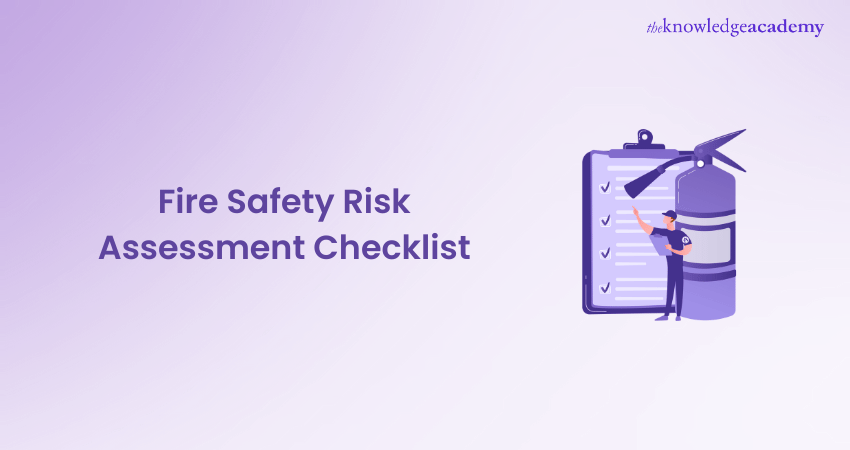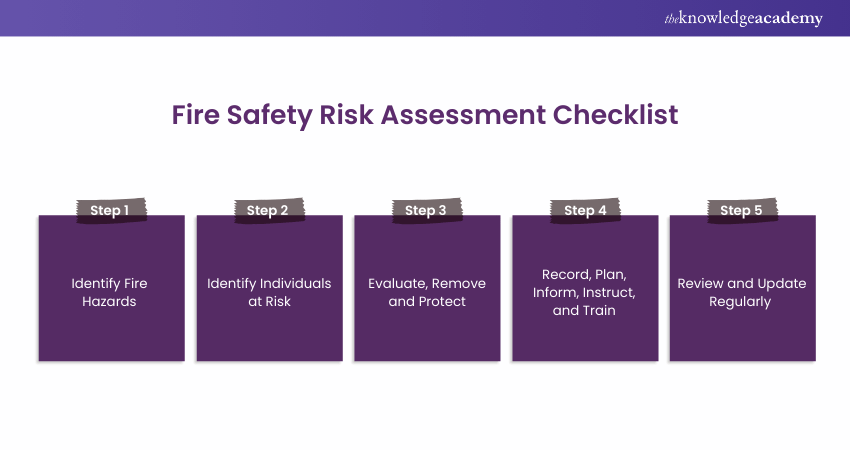We may not have the course you’re looking for. If you enquire or give us a call on +41 315281584 and speak to our training experts, we may still be able to help with your training requirements.
Training Outcomes Within Your Budget!
We ensure quality, budget-alignment, and timely delivery by our expert instructors.

Fire safety is vital in every setting—be it commercial, industrial, or residential. Prioritising the protection of lives, property, and the environment is essential. To reduce the risk of fire-related incidents and ensure readiness, it’s crucial to raise Fire Safety Awareness and develop a thorough Fire Safety Risk Assessment Checklist.
In this blog, we’ll delve into the key aspects of fire safety and provide you with a comprehensive Fire Safety Risk Assessment Checklist. From proactive prevention to effective emergency response, discover how to equip yourself with the necessary tools and knowledge to mitigate fire risks. Take the essential steps to safeguard what matters most and ensure a safe, protected environment.
Table of Contents
1) Purpose of Fire Safety Risk Assessment
2) Key Elements of Fire Safety Risk Assessment
3) Why Conduct a Fire Risk Assessment?
4) Comprehensive Fire Safety Risk Assessment Checklist
5) Conclusion
Purpose of Fire Safety Risk Assessment
A Fire Safety Risk Assessment is developed to identify potential fire hazards and determine who may be at risk. The goal is to find ways to eliminate or reduce these risks effectively. An assessment not only provides crucial information in the event of a fire but also ensures that established Fire Safety Rules are followed.
A thorough assessment makes a swift and orderly evacuation becomes possible, allowing emergency services to reach the site without obstruction. A well-executed Risk Assessment, which includes identifying and implementing comprehensive Fire Safety Precautions, serves as the first line of defence against the devastating impact of a fire.
Key Elements of Fire Safety Risk Assessment
The process of a Fire Safety Risk Assessment hinges on the principles of hazard identification, risk evaluation, and risk control measures. The assessment involves the following:
a) A close inspection of the premises' structure
b) A keen understanding of the potential sources of ignition
c) Identification of flammable materials
d) Careful consideration of the individuals who could be at risk
Particular attention should be paid to those who may require special consideration in a fire, such as the elderly, disabled individuals, or children.
Empower yourself with vital skills to protect lives and property – sign up for our Fire Risk Assessment Training today!
Why Conduct a Fire Risk Assessment?
Performing a Fire Risk Assessment isn't just about meeting legal obligations. It is a proactive measure to mitigate the likelihood of fire incidents. Fires not only inflict property damage but also tarnish a business's reputation and erode trust in its commitment to safety.
Conversely, undergoing a Fire Risk Assessment communicates to clients that the business prioritises fire prevention and safety. Regular assessments bolster confidence among potential investors or partners, showcasing the business's reliability and risk awareness.
By demonstrating a commitment to proactive risk management, a business safeguards its assets effectively. This approach also helps cultivate trust and credibility within the community and industry. Performing a comprehensive Fire Risk Assessment goes beyond mere compliance. It signifies a proactive stance towards safeguarding lives and property.
Moreover, by identifying potential fire hazards, businesses show their dedication to safety. Implementing effective prevention measures further reinforces this commitment, resonating with both clients and stakeholders alike.
Furthermore, regular assessments serve as a testament to the business's adaptability and responsiveness to evolving risks. They can instil confidence in their ability to navigate unforeseen challenges.
Comprehensive Fire Safety Risk Assessment Checklist
Conducting a Risk Assessment can often feel overwhelming. To make it more manageable, we've simplified the process by following the recommendations of the Health and Safety Executive (HSE). Our Fire Safety Risk Assessment Checklist breaks it down into five key steps to ensure you cover all aspects effectively.

Step 1: Identify Fire Hazards
The first step is to ensure that you identify the potential fire hazards. This includes identifying the following:
1) Potential Sources of Ignition: Electrical equipment, heating systems, naked flames, smokers' materials, cooking appliances, etc.
2) Fuel Sources: Flammable liquids and gases, combustible materials such as paper and wood, waste storage areas, etc.
3) Oxygen Sources: Natural air flow, oxygen cylinders, air conditioning systems, etc.
Step 2: Identify Individuals at Risk
The second step is to identify the individuals at the highest potential risk. This includes the identification of:
1) Employees working in close proximity to fire hazards
2) Visitors who are unfamiliar with the premises and the Fire Safety procedures
3) Individuals with mobility issues or other disabilities may require assistance during an evacuation
4) People working alone or in isolated areas
5) Children or elderly individuals who may need additional help
Step 3: Evaluate, Remove or Reduce, and Protect from Risk
The third step is to evaluate, remove or, reduce, and protect individuals at potential risk. This includes performing the following:
1) Evaluate the likelihood of a fire starting and the harm it could cause.
2) Remove or reduce fire hazards where possible. For example, they can maintain electrical equipment, store flammable materials safely, and enforce a no-smoking policy.
3) Protect individuals by ensuring there are adequate means of escape. Clearly marked exit routes should always be provided and kept free from obstructions.
4) Install and maintain suitable fire detection and alarm systems.
5) Provide suitable fire-fighting equipment such as fire extinguishers, and ensure staff know how to use them. This highlights the importance of Fire Safety Equipment in emergency response plans.
6) Consider the need for an automatic sprinkler system or other fire suppression systems.
Step 4: Record, Plan, Inform, Instruct, and Train
The fourth step is to record the findings of your Fire Safety Risk Assessment. Next, inform, instruct, and train people to ensure they are prepared for a fire emergency. It includes the following steps:
1) Record all the findings of your Risk Assessment and the actions you have taken. Keep this record in a safe and accessible place.
2) Develop a clear and detailed emergency fire evacuation plan
3) Inform all staff and visitors about the identified risks, your Fire Safety plan, and the procedures to follow in the event of a fire
4) Provide appropriate instruction and training to staff about Fire Safety in the workplace, including fire drills
Step 5: Review and Update Regularly
The fifth step is to review and update your Risk Assessment regularly by doing the following:
1) Make sure to review your Risk Assessment regularly (at least annually), and when any significant changes occur in your premises or procedures
2) Update your Risk Assessment and procedures as necessary following your review
Conclusion
An in-detail and regularly updated Fire Safety Risk Assessment is important for safeguarding lives and properties. Using the aforementioned Fire Safety Risk Assessment Checklist and remaining mindful of your specific context will ensure a robust assessment. Remember, understanding fire risks and being prepared for emergencies is not just a regulatory requirement but a fundamental duty of care.
Learn to identify the different types of Fire Extinguishers and their colour codes with our Fire Extinguisher Training – Register now!
Frequently Asked Questions

Fire Risk Assessment scoring typically involves evaluating three key components: the likelihood of a fire occurring, the potential severity of harm, and the number of people exposed to the risk. These factors help decide the overall risk level and guide necessary precautions.

The four main steps to a safe fire evacuation include: 1) Immediate activation of the fire alarm, 2) Swiftly directing everyone to the nearest safe exit, 3) Ensuring all exits are clear and accessible, and 4) Conducting a headcount at the designated assembly point to confirm everyone's safety.

The Knowledge Academy takes global learning to new heights, offering over 30,000 online courses across 490+ locations in 220 countries. This expansive reach ensures accessibility and convenience for learners worldwide.
Alongside our diverse Online Course Catalogue, encompassing 17 major categories, we go the extra mile by providing a plethora of free educational Online Resources like News updates, Blogs, videos, webinars, and interview questions. Tailoring learning experiences further, professionals can maximise value with customisable Course Bundles of TKA.

The Knowledge Academy’s Knowledge Pass, a prepaid voucher, adds another layer of flexibility, allowing course bookings over a 12-month period. Join us on a journey where education knows no bounds.

The Knowledge Academy offers various Fire Safety Training, including Fire Safety Training, Fire Warden Training, Fire Extinguisher Training and Fire Risk Assessment Training. These courses cater to different skill levels, providing comprehensive insights into the Fire Safety System.
Our Health & Safety Blogs cover a range of topics related to Fire Safety, offering valuable resources, best practices, and industry insights. Whether you are a beginner or looking to advance your Fire Safety skills, The Knowledge Academy's diverse courses and informative blogs have you covered.
Upcoming Health & Safety Resources Batches & Dates
Date
 Fire Safety Training
Fire Safety Training
Fri 21st Feb 2025
Fri 27th Jun 2025
Fri 26th Sep 2025
Fri 21st Nov 2025







 Top Rated Course
Top Rated Course



 If you wish to make any changes to your course, please
If you wish to make any changes to your course, please


